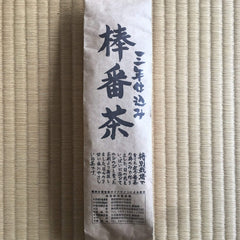おそらく、あなたは日本茶、特に番茶をご存知で、実際に飲んだことがあるかもしれません。しかし、三年番茶とは一体何なのでしょうか?普通の番茶やほうじ茶とはどう違うのでしょうか?今日は、皆さんが新しいお茶を発見したり、お茶にもっと親しんだりするお手伝いができれば幸いです。
一般的に、日本茶( 煎茶)は、茶の木の新芽を収穫、蒸し、加工して作られます。これらの種類のお茶は、新鮮なうちに飲むのが最高とされています。しかし、三年番茶は、3年間刈り取られていない茶の木、または3年間成熟した茎と葉から作られるという点で少し異なります。煎茶と比較して、人によっては刺激となる可能性のあるカフェインとタンニンが少ないため、あらゆる年齢層に優しいお茶とされています。日本では、このお茶はそのまま飲むか、梅を少し加えたり、醤油を少し加えたり、すりおろした生姜を加えたりして楽しむ人もいます。
現代の三年番茶の2つの製法
1. 3年間熟成
 三年番茶を作るための最初の方法は、お茶を3年間熟成させることです。茶樹から新芽を摘むのではなく、秋に収穫した番茶(成熟した茶葉と茎)を使用します。これらの茶葉の茎は、荒茶(ふるいにかけていない粗茶)や多くのお茶と同様に蒸されますが、その後、常温で3年間熟成されます。これが三年番茶の条件です。湯呑みでは、 樽井茶園の三年番茶と上島さんの三年番茶がこの方法で作られています。
三年番茶を作るための最初の方法は、お茶を3年間熟成させることです。茶樹から新芽を摘むのではなく、秋に収穫した番茶(成熟した茶葉と茎)を使用します。これらの茶葉の茎は、荒茶(ふるいにかけていない粗茶)や多くのお茶と同様に蒸されますが、その後、常温で3年間熟成されます。これが三年番茶の条件です。湯呑みでは、 樽井茶園の三年番茶と上島さんの三年番茶がこの方法で作られています。
 樽井茶園の三年番茶を購入
樽井茶園の三年番茶を購入

上島さんの三年番茶を買う
このお茶の起源は、唐の時代に日本に来た僧侶の影響を強く受けたと言われています。元々は、冬の寒い時期に野生の茶の木を刈り取り、茶壺(ちゃつぼ)に入れて蓋をし、和紙を何層にも重ねて密封し、3年間貯蔵・熟成させて作られていました。
2. 3年間の茶樹栽培
 二つ目の方法は、3年間刈り取られたり収穫されたりしていない葉と茎を刈り取る方法です。この代替三年番茶を作る工程は、蒸し、乾燥、焙煎という点で一般的な荒茶の工程と似ていますが、この方法では薪火で焙煎する点が異なります。この方法で作られた三年番茶は、長い生育期間のため、はっきりとした、全く異なるテロワール(土壌)を持っています。伝統的には、すべての工程はすべて手作業で行われていました。 あゆみ農園のワハハ三年番茶は、 3年間刈り取られることなく育てられた茶樹から作られています。
二つ目の方法は、3年間刈り取られたり収穫されたりしていない葉と茎を刈り取る方法です。この代替三年番茶を作る工程は、蒸し、乾燥、焙煎という点で一般的な荒茶の工程と似ていますが、この方法では薪火で焙煎する点が異なります。この方法で作られた三年番茶は、長い生育期間のため、はっきりとした、全く異なるテロワール(土壌)を持っています。伝統的には、すべての工程はすべて手作業で行われていました。 あゆみ農園のワハハ三年番茶は、 3年間刈り取られることなく育てられた茶樹から作られています。


 あゆみ農園の「ワッハハ三年番茶」は、3年間放置された茶樹から作られています。あゆみさんは友人たちと協力し、茶樹の倍以上にもなった枝を切り落としました。その後、枝を整理(絡み合った蔓や草を取り除く)し、トラックに積み込みます。写真は、昨年2月の満月の日に収穫した三年番茶の様子です。写真は、あゆみ農園(チットラット)にて。
あゆみ農園の「ワッハハ三年番茶」は、3年間放置された茶樹から作られています。あゆみさんは友人たちと協力し、茶樹の倍以上にもなった枝を切り落としました。その後、枝を整理(絡み合った蔓や草を取り除く)し、トラックに積み込みます。写真は、昨年2月の満月の日に収穫した三年番茶の様子です。写真は、あゆみ農園(チットラット)にて。
yumi FarmのWha-ha-ha 三年番茶を購入する
マクロビオティック愛好家のためのお茶
日本には、植物の生育環境によって温冷の性質を持つとする中国伝統医学の影響を受けた、独自のマクロビオティック食文化があります。こうした考え方を持つ人にとって、三年番茶は、太陽の光を浴びた若い上部の葉ではなく、茎の下部、さらには成熟した葉から作られるため、根菜に近い特性を持つと言えます。そのため、マクロビオティックの観点から見ると、体を温める効果があると考えられます。
三年番茶は番茶やほうじ茶とどう違うのですか?
このブログ投稿を締めくくる前に、番茶とほうじ茶の違いについて触れ、三年番茶がどのような位置づけにあるかを理解したいと思います。日本茶にはたくさんの種類があるように思えることもあるので、これらの違いを強調することで、日本茶の用語にもっと慣れ親しんでいただければ幸いです。
番茶(番茶)
番茶は民間茶として知られ、一般的には大きく育った茶葉から作られたお茶を指します。番茶は通常、煎茶よりも大きな茶葉から作られ、秋から初冬にかけて摘まれます。一方、煎茶は通常、春に摘まれた最初の茶葉から作られます。番茶の風味は渋みが強い傾向がありますが、春摘みの緑茶よりもカフェイン含有量は低くなります。
煎茶が地域によって異なるように、番茶にも様々な種類があります。一般的に「番茶」とは、比較的シンプルな製法でありながら、多様な製法で作られる、無数の民間茶・地方茶を指します。これらの民間茶はますます希少になり、特定の民間茶で知られる地域に住んでいる人でも、これらの逸品を知らない人もいるほどです。番茶は煎茶に比べて品質が低いと考える人もいますが、番茶には地域の歴史、文化、そしてテロワールが反映されており、その違いは見逃せません。様々な種類の番茶があり、抹茶のアフターティーとしても最適です。
 風流番茶店の阿波番茶は、徳島県上勝町の希少な民俗茶です。
風流番茶店の阿波番茶は、徳島県上勝町の希少な民俗茶です。
一般的に番茶は煎茶に比べて品質が低いと言われていますが(栽培と加工は煎茶と同じで、使用する茶葉の品質が異なるため)、番茶を過小評価すべきではありません。番茶には様々な種類があり、試してみる価値は十分にあります。さらに、抹茶のアフターティーとしても最適です!
ほうじ茶(ほうじ茶)
ほうじ茶は焙じたお茶、一般的には番茶を焙じたものを指します。しかし、茎を焙じたもの、春摘みまたは夏摘みの茶葉を焙じたもの、巻き上げていない茶葉(通常は京番茶)など、様々な組み合わせやバリエーションがあります。強火で焙じるため、ほうじ茶にはアミノ酸(うま味)、カテキン(渋み)、カフェイン、ビタミンCが少なくなっています。香り高く爽やかなお茶で、食事とよく合い、また食後にも楽しめます。日本では、温かいお茶でも冷たいお茶でも飲まれる日常的なお茶であり、レストランでもよく提供されています。
 乾燥させたほうじ茶の葉、撮影:Yunomi
乾燥させたほうじ茶の葉、撮影:Yunomi
まとめると、三年番茶、番茶、ほうじ茶の大きな違いは何でしょうか?主な違いは、収穫と製造工程、そしてもちろん3年間の栽培または熟成期間にあります。それ以外は、これらのお茶は比較的よく似ています。実際、日本の食品表示法では、三年番茶は製造工程の最後に焙煎する必要があるため、番茶ではなくほうじ茶に分類されます。
 日本茶検定公式テキスト(日本茶の全てがわかる本;日本茶検定公式テキスト)を基にした、岸田萌による日本茶の種類図。
日本茶検定公式テキスト(日本茶の全てがわかる本;日本茶検定公式テキスト)を基にした、岸田萌による日本茶の種類図。
では、淹れ方はどうでしょうか?番茶とほうじ茶は、九州の急須を使って典型的な方法で淹れますが、お湯は他のお茶よりも熱くなります。三年番茶の淹れ方は主に2通りあります。1つは、大きな急須に熱湯を注ぐ方法です。伝統的な淹れ方は、コンロの上のやかんで淹れる方法です。やかんの茶漉しに茶葉を入れ、茶葉が浸るくらいのお湯を沸かし、弱火にして5~10分ほど煮て火を止めます。煮終わったら、茶葉を入れたやかんの茶漉しを取り出せば、出来上がりです。大きなやかんにたっぷり淹れておけば、コンロで温め直したり、室温で一日中飲んだりできます。夏場は冷やして淹れて飲むこともできます。もちろん、個人の好みが重要です。
あなたの好きな番茶やほうじ茶は何ですか?他にもっと知りたい日本茶があれば、ぜひ教えてください!
目玉画像:静岡県川根市にある三年番茶を加工するピース製茶工場で、薪火で三年番茶の枝葉をじっくり焙煎する様子。写真提供:Ayumi Farms、 Cittorattu 。



